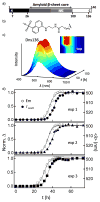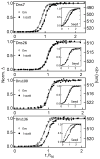Residue-specific fluorescent probes of α-synuclein: detection of early events at the N- and C-termini during fibril assembly
- PMID: 21338068
- PMCID: PMC3074234
- DOI: 10.1021/bi2000824
Residue-specific fluorescent probes of α-synuclein: detection of early events at the N- and C-termini during fibril assembly
Abstract
In the Parkinson's disease-associated state, α-synuclein undergoes large conformational changes, forming ordered, β-sheet-containing fibrils. To unravel the role of specific residues during the fibril assembly process, we prepared single-Cys mutants in the disordered (G7C and Y136C) and proximal (V26C and L100C) fibril core sites and derivatized them with environmentally sensitive dansyl (Dns) fluorophores. Dns fluorescence exhibits residue specificity in spectroscopic properties as well as kinetic behavior; early kinetic events were revealed by probes located at positions 7 and 136 compared to those at positions 26 and 100.
Figures


Similar articles
-
Mechanistic insight into the relationship between N-terminal acetylation of α-synuclein and fibril formation rates by NMR and fluorescence.PLoS One. 2013 Sep 18;8(9):e75018. doi: 10.1371/journal.pone.0075018. eCollection 2013. PLoS One. 2013. PMID: 24058647 Free PMC article.
-
Molecular Rotors Detect the Formation and Conversion of α-Synuclein Oligomers.ACS Appl Mater Interfaces. 2025 Feb 19;17(7):10499-10508. doi: 10.1021/acsami.4c21710. Epub 2025 Feb 5. ACS Appl Mater Interfaces. 2025. PMID: 39907186 Free PMC article.
-
A triple-emission fluorescent probe reveals distinctive amyloid fibrillar polymorphism of wild-type alpha-synuclein and its familial Parkinson's disease mutants.Biochemistry. 2009 Aug 11;48(31):7465-72. doi: 10.1021/bi9003843. Biochemistry. 2009. PMID: 19586054
-
Insights into the Molecular Mechanisms of Alzheimer's and Parkinson's Diseases with Molecular Simulations: Understanding the Roles of Artificial and Pathological Missense Mutations in Intrinsically Disordered Proteins Related to Pathology.Int J Mol Sci. 2018 Jan 24;19(2):336. doi: 10.3390/ijms19020336. Int J Mol Sci. 2018. PMID: 29364151 Free PMC article. Review.
-
Molecular mechanisms of alpha-synuclein neurodegeneration.Biochim Biophys Acta. 2009 Jul;1792(7):616-24. doi: 10.1016/j.bbadis.2008.09.013. Epub 2008 Oct 9. Biochim Biophys Acta. 2009. PMID: 18955133 Free PMC article. Review.
Cited by
-
Taking a Bite Out of Amyloid: Mechanistic Insights into α-Synuclein Degradation by Cathepsin L.Biochemistry. 2017 Aug 1;56(30):3881-3884. doi: 10.1021/acs.biochem.7b00360. Epub 2017 Jun 28. Biochemistry. 2017. PMID: 28614652 Free PMC article.
-
Native chemical ligation of thioamide-containing peptides: development and application to the synthesis of labeled α-synuclein for misfolding studies.J Am Chem Soc. 2012 Jun 6;134(22):9172-82. doi: 10.1021/ja2113245. Epub 2012 Apr 2. J Am Chem Soc. 2012. PMID: 22468862 Free PMC article.
-
Physiological C-terminal truncation of α-synuclein potentiates the prion-like formation of pathological inclusions.J Biol Chem. 2018 Dec 7;293(49):18914-18932. doi: 10.1074/jbc.RA118.005603. Epub 2018 Oct 16. J Biol Chem. 2018. PMID: 30327435 Free PMC article.
-
Transmission electron microscopy characterization of fluorescently labelled amyloid β 1-40 and α-synuclein aggregates.BMC Biotechnol. 2011 Dec 19;11:125. doi: 10.1186/1472-6750-11-125. BMC Biotechnol. 2011. PMID: 22182687 Free PMC article.
-
Development of fluorophores for the detection of oligomeric aggregates of amyloidogenic proteins found in neurodegenerative diseases.Front Chem. 2023 Dec 22;11:1343118. doi: 10.3389/fchem.2023.1343118. eCollection 2023. Front Chem. 2023. PMID: 38188930 Free PMC article. Review.
References
Publication types
MeSH terms
Substances
Grants and funding
LinkOut - more resources
Full Text Sources

